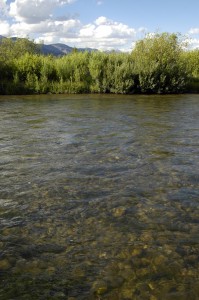(Beyond Pesticides, October 27, 2011) Forty-seven students from Edgewood Middle School in St. Clair Township, Ohio, reportedly fell ill after the school’s hired pest control company sprayed the herbicide Momentum, which contains the toxic ingredients 2,4-D, triclopyr and clopyralid, on nearby playing fields to treat for clover and other weeds. The incident and others like it demonstrate the need for a comprehensive national policy to protect children from harmful and unnecessary exposure to toxic chemicals. Six students were taken to nearby hospitals and twenty-one students total were treated for symptoms, including headaches, breathing difficulties, nausea and dizziness.
Children are especially sensitive and vulnerable to pesticides because of their rapid development and behavior patterns. Adverse health effects, such as nausea, dizziness, respiratory problems, headaches, rashes, and mental disorientation, may appear even if a pesticide is applied according to label directions, which may have been the case in this situation. Pesticide exposure can have long-term adverse effects, including damage to a child‚Äôs neurological, respiratory, immune, and endocrine system and increased asthma symptoms. Studies show that children living in households where pesticides are used suffer elevated rates of leukemia, brain cancer, and soft tissue sarcoma. For more information, see Beyond Pesticides’ fact sheet, “Children and Pesticides Don’t Mix.”
An odor was first detected by a student in a classroom where a few other students reportedly complained of headaches and coughing around 10:30 a.m. Tuesday October 11. The initial evacuation of the room was around 11 a.m., said John Thomas, a spokesman for the school district to the Dayton Daily News. Eventually, the odor filled the entire building which forced the evacuation of the entire school. Parents were advised to take affected students home, wash their clothes, have them shower and spend the rest of the day breathing fresh air.
Many of the symptoms that children suffered at Edgwood Middle School are common in school children and may also have other causes, which means that pesticide-related illnesses often go unrecognized and unreported. Emergency workers had not yet identified the source of the odor and what was making the students ill until after a crew in hazmat gear tested the air, at which point the six students were already sent to the hospital. Upon realizing that the source of the problem was a weedkiller, school officials were concerned that the children had been lead to the contaminated field: ‚ÄúOur biggest concern was when we got here we didn‚Äôt realize that the problem was outside,‚ÄĚ St Clair Township Fire Chief Terry White told Cincinnati.com. By 1:30 p.m., school officials were told that the building was clear of residue and those students that didn‚Äôt go home went back inside.
Momentum, the herbicide that was sprayed on school playing fields to control clover and other weeds is made up of three active ingredients: 2,4-D, triclopyr and clopyralid. 2,4-D has been linked to cancer, reproductive effects, endocrine disruption, kidney and liver damage, is neurotoxic and toxic to beneficial insects (such as bees), earthworms, birds, and fish. Scientific studies have confirmed significantly higher rates of non-Hodgkin’s lymphoma for farmers who use 2,4-D than those who don’t; dogs whose owners use 2,4-D on their lawns are more likely to develop canine malignant lymphoma than those whose owners do not. Despite the known health and environmental effects of 2,4-D, it is the top selling herbicide for non-agricultural use, such as lawns, in the United States. It is also the fifth most commonly used herbicide in the agricultural sector and total annual usage in the U.S. tops 40 million pounds.
Clopyralid is a carboxylic acid herbicide classified by EPA in acute toxicity class III as slightly toxic. Laboratory studies have shown that clopyralid is a severe eye irritant and dermal irritation has also been noted which can lead to skin sensitization for prolonged skin exposures. Some developmental and reproductive effects have been observed in laboratory animals. The livers and kidneys of rats as well as the livers of dogs were affected by changes in weight and decreased red blood cell counts. Another study found that weights of rabbit fetuses decreased at both low and high doses of clopyralid. Skeletal abnormalities were also observed in these fetuses at all doses.
Clopyralid is also a persistent herbicide that breaks down extremely slowly. The herbicide, which does not break down during the composting process, has been found in compost made from recycled grass, straw, and manure. In 2002, the state of Washington banned the use of clopyralid on lawns and turf in order to keep the chemical from contaminating compost supplies. That same year, California found that 65% of the compost samples tested positive for clopyralid, which led to the cancellation of residential uses for clopyralid in the state.
There are documented effects on reproduction, fetal development, and organ function, as well as irritation when exposed to high doses of the other active ingredient in the herbicide Momentum, triclopyr. Subchronic and chronic feeding studies in dogs and rodents found damage to both the kidney and liver. Data has also shown birth defects and adverse effects on reproduction associated with chronic exposure. Pregnant rodents exposed to the chemical had lower litter numbers and a higher incidence of birth abnormalities in offspring than did those which were not exposed. Triclopyr is generally considered to be non-carcinogenic, but several laboratory tests have shown an increase in the incidents of breast cancer and genetic damage in rat embryos. Triclopyr is also toxic to a range of wildlife, and its persistence can vary greatly depending on the application site, but some studies have shown it to persist longer than a year under certain conditions.
The field was sprayed earlier that morning, while classroom windows were open. It‚Äôs not clear from reports whether or not school was in session at the time of spray, but Jeff Galloway, director of Butler County Emergency Management Agency told the Dayton Daily News that they suspect that weather conditions, ‚Äúheavy, humid air and a breeze,‚ÄĚ pushed the chemical into the school.
School is a place where children need a healthy body and a clear head in order to learn. Numerous scientific studies find that pesticides typically used in schools are linked to chronic health effects such as cancer, asthma, neurological and immune system diseases, reproductive problems, and developmental and learning disabilities. Integrated Pest Management (IPM) in schools has proven to be an effective and economical method of pest management that can prevent pest problems and, if carefully devined, eliminate the use of hazardous pesticides in school buildings and on school grounds.
Many communities across the country have taken a stand against the use of toxic pesticides on their lawns and landscapes. The state of New York passed the Child Safe Playing Fields Act which prohibits the use of toxic pesticides on school and daycare center playgrounds, turf, athletic and playing fields. Earlier this year, a bill to prohibit the use of most lawn pesticides on public and private playgrounds, recreation fields and daycare centers was introduced in New Jersey, The Child Safe Playing Field Act has passed the Senate Budget Committee, and is awaiting posting in the Senate. This bill will support the over 30 communities in New Jersey that have made their parks pesticide-free zones and have adopted an IPM program for managing town property by passing a resolution adopting a pesticide reduction policy. Connecticut and Illinois have also moved forward to reduce children’s exposures to lawn pesticides.
Exposure to toxic pesticides and other chemicals while children are at school is an unacceptable and completely unnecessary risk. This incident should not have happened and is a prime example for why it is time for a national policy that would prevent this from happening again and protect every child in the United States. Federal legislation, the School Environment Protection Act of 2009 (SEPA), was introduced by Rep. Rush Holt and would protect school children from pesticides used both indoors and on all school grounds nationwide. The legislation also bans the use of synthetic fertilizers. SEPA was first introduced in November 1999 in both the U.S. Senate and House; and has been reintroduced every Congressional session since. The bill language is based on state school pest management laws. It also mirrored the structure of the Organic Foods Production Act of 1990, which established a national committee to oversee the program as well as established a list of pesticides allowed for use within the program. A form of SEPA has passed the U.S. Senate twice since and, together with other legislation, indicates broad support for a national mandate to stop hazardous pesticide use in schools. To learn more about this legislation and help its passage, see Beyond Pesticides’ SEPA webpage.
Sources: Dayton Daily News, Cincinnati.com
All unattributed positions and opinions in this piece are those of Beyond Pesticides.














